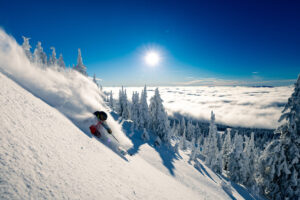If you’ve ever been on a chairlift when warmer temperatures call for rain but instead noticed snowflakes soaking into your coat, this question applies to you: Can it snow when temperatures are above freezing?
Snow temperatures are cold at cloud level in most cases, causing the precipitation to start out as snow. The snowflakes retain their flakiness and fall as snow if the air temperature is colder than freezing all the way from the cloud to the ground.
Snow forms when the atmospheric temperature is at or below freezing (0 degrees Celsius or 32 degrees Fahrenheit) and there is a minimum amount of moisture in the air. That’s when the snow will reach the ground.
Cold vs. warm air
The air between the cloud and the ground in certain situations is not always below freezing. This actually happens more frequently along the east coast of the U.S. When big storms move south to north along the coastline (known as Nor’Easters), the flow around the storm pulls in air from the Atlantic Ocean. The oceanic air is very moist and can produce lots of snow. This is also bad at times, though, because the same oceanic air is also warm. If the air is warmer than freezing, the snowflakes that fall from the clouds will hit the warm air on their way to the ground and melt into raindrops.
As the raindrop falls, it might encounter air that is once again colder than freezing. Since colder air is heavier than warmer air, sometimes it can ‘hang out’ very close to the ground and refuse to move despite the best efforts of the warm air trying to push it out of the way.
So back to our example, the snowflake that melted into a raindrop would hit this colder air near the ground. If the cold air is thick enough and extends from the ground up a few thousand feet, the raindrop will have enough time to melt back into a solid ball of ice, which is called sleet. If the cold air is just near the ground and only extends a few hundred feet above the ground, the raindrop won’t spend enough time in the cold air to freeze back into sleet, but it will freeze when it hits a cold surface on the ground (power line, grass, road, etc).
We can all use weather models to find snow
Is it ever too cold to snow?
No. it can snow even at an incredibly cold temperature as long as there is some source of moisture in the air and a way to lift or cool the air. Still, most heavy snowfalls occur relatively warm. air temperatures near the ground. That’s because air can hold more water vapor at warmer temps.
When temperatures are above freezing

The snowflake will fall as a snowflake all the way toward the ground if the temperature at the ground is right around or just above freezing. The snowflake might not have enough time to melt as it falls since it’s only spending a short time in the warmer air before it hits the ground. So yes, as the graphic shows, snow can fall all the way to the ground even when temperatures are above freezing at the surface.
One last “cool fact,” (so to speak) is that the temperature can actually cool a few degrees due to evaporation if it’s just starting to snow. Some of the flakes will evaporate and this process actually cools the air if snowflakes fall into drier air. Keep an eye on the temperature when the first flakes begin to fly during the next snowstorm. When you catch sight of the first flakes, check back just a few minutes later if the temperature is just above freezing. Chances are the temperature fell a few degrees because of evaporation and hopefully, this gives us a better shot of having that snow accumulate into a meaningful powder day.





